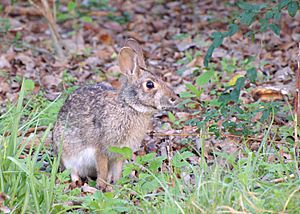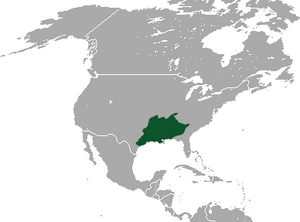Swamp rabbit facts for kids
Quick facts for kids Swamp rabbitTemporal range: Pleistocene-recent
|
|
|---|---|
 |
|
| Conservation status | |
| Scientific classification | |
| Genus: |
Sylvilagus
|
| Species: |
aquaticus
|
 |
|
| Swamp rabbit range | |
The swamp rabbit (Sylvilagus aquaticus), also known as the swamp hare, is a type of cottontail rabbit that lives in wet places. You can find these large rabbits in the swamps and wetlands of the Southern United States. People sometimes call them marsh rabbits or cane-cutters. Swamp rabbits love water and are excellent swimmers!
Contents
What is a Swamp Rabbit?
Swamp rabbits are bigger than most other cottontail rabbits. They are specially adapted to live in watery environments. Unlike many rabbits, they don't mind getting wet and can even swim to escape danger or find food.
Where Do They Live?
Swamp rabbits are found in the southeastern parts of the United States. Their home includes states like Alabama, Arkansas, Florida, Georgia, Illinois, Kentucky, Louisiana, Mississippi, Missouri, Oklahoma, South Carolina, Tennessee, and Texas. They prefer areas with lots of water, such as swamps, marshes, floodplains, and along rivers and streams.
Their Wet Homes
These rabbits like places where the ground is often wet or flooded. They look for dense plants and bushes near water, which provide good cover from predators. They can often be seen near cypress swamps, hardwood forests, and cane thickets.
What Do Swamp Rabbits Look Like?
Swamp rabbits are quite large for a rabbit, weighing between 3 to 6 pounds (1.4 to 2.7 kg). They can be up to 22 inches (55 cm) long.
Fur and Features
Their fur is usually dark brown or black on their back, with a white belly. They have small, round ears and a short, fluffy tail that is brownish-white underneath. Their feet are not as furry as other rabbits, which helps them move through muddy or wet areas.
What Do They Eat?
Swamp rabbits are herbivores, meaning they only eat plants. Their diet changes depending on what plants are available in their wet habitats.
Favorite Foods
They mostly eat grasses, sedges, and other green plants found in swamps and marshes. They also enjoy eating the bark and twigs of young trees and shrubs. Sometimes, they will eat berries and seeds.
How Do They Behave?
Swamp rabbits are mostly active during the early morning and late afternoon, but they can be seen at any time of day. They are generally solitary animals, meaning they prefer to live alone.
Swimming and Escaping
One of their most amazing abilities is swimming. When threatened, a swamp rabbit will often jump into the water and swim away. They can even dive underwater and hide with only their nose sticking out to breathe! This skill helps them escape from predators like foxes, bobcats, and large birds.
Building Nests
Female swamp rabbits build their nests in shallow depressions on the ground. They line these nests with grass and fur from their own bodies to keep the babies warm and hidden. These nests are often found in dense vegetation near water.
Reproduction and Life Cycle
Swamp rabbits can have babies several times a year.
Baby Rabbits
A female swamp rabbit usually gives birth to 1 to 6 babies, called kits. The kits are born without fur and with their eyes closed. They are very helpless at birth. The mother will nurse them for a few weeks until they are old enough to start eating solid food and explore on their own.
How Long Do They Live?
In the wild, swamp rabbits usually live for about 1 to 2 years. However, if they avoid predators and diseases, they can live longer, sometimes up to 5 years.
Conservation Status
The swamp rabbit is currently listed as "Least Concern" (LC) by the International Union for Conservation of Nature (IUCN). This means that their population is stable and they are not considered to be at high risk of extinction right now.
Threats to Swamp Rabbits
Even though they are not endangered, swamp rabbits can face threats. Habitat loss due to human development, such as draining wetlands for building, can reduce the places where they can live. Pollution of their watery homes can also be a problem.
See also
In Spanish: Conejo de pantano para niños
Images for kids




